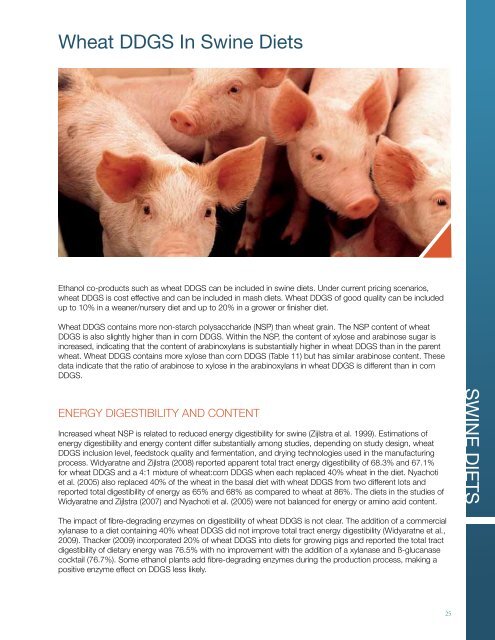Wheat DDGS Feed Guide - Western Canadian Feed Innovation ...
Wheat DDGS Feed Guide - Western Canadian Feed Innovation ...
Wheat DDGS Feed Guide - Western Canadian Feed Innovation ...
You also want an ePaper? Increase the reach of your titles
YUMPU automatically turns print PDFs into web optimized ePapers that Google loves.
<strong>Wheat</strong> <strong>DDGS</strong> In Swine Diets<br />
Ethanol co-products such as wheat <strong>DDGS</strong> can be included in swine diets. Under current pricing scenarios,<br />
wheat <strong>DDGS</strong> is cost effective and can be included in mash diets. <strong>Wheat</strong> <strong>DDGS</strong> of good quality can be included<br />
up to 10% in a weaner/nursery diet and up to 20% in a grower or finisher diet.<br />
<strong>Wheat</strong> <strong>DDGS</strong> contains more non-starch polysaccharide (NSP) than wheat grain. The NSP content of wheat<br />
<strong>DDGS</strong> is also slightly higher than in corn <strong>DDGS</strong>. Within the NSP, the content of xylose and arabinose sugar is<br />
increased, indicating that the content of arabinoxylans is substantially higher in wheat <strong>DDGS</strong> than in the parent<br />
wheat. <strong>Wheat</strong> <strong>DDGS</strong> contains more xylose than corn <strong>DDGS</strong> (Table 11) but has similar arabinose content. These<br />
data indicate that the ratio of arabinose to xylose in the arabinoxylans in wheat <strong>DDGS</strong> is different than in corn<br />
<strong>DDGS</strong>.<br />
ENERGy DIGESTIBILITy AND CONTENT<br />
Increased wheat NSP is related to reduced energy digestibility for swine (Zijlstra et al. 1999). Estimations of<br />
energy digestibility and energy content differ substantially among studies, depending on study design, wheat<br />
<strong>DDGS</strong> inclusion level, feedstock quality and fermentation, and drying technologies used in the manufacturing<br />
process. Widyaratne and Zijlstra (2008) reported apparent total tract energy digestibility of 68.3% and 67.1%<br />
for wheat <strong>DDGS</strong> and a 4:1 mixture of wheat:corn <strong>DDGS</strong> when each replaced 40% wheat in the diet. Nyachoti<br />
et al. (2005) also replaced 40% of the wheat in the basal diet with wheat <strong>DDGS</strong> from two different lots and<br />
reported total digestibility of energy as 65% and 68% as compared to wheat at 86%. The diets in the studies of<br />
Widyaratne and Zijlstra (2007) and Nyachoti et al. (2005) were not balanced for energy or amino acid content.<br />
The impact of fibre-degrading enzymes on digestibility of wheat <strong>DDGS</strong> is not clear. The addition of a commercial<br />
xylanase to a diet containing 40% wheat <strong>DDGS</strong> did not improve total tract energy digestibility (Widyaratne et al.,<br />
2009). Thacker (2009) incorporated 20% of wheat <strong>DDGS</strong> into diets for growing pigs and reported the total tract<br />
digestibility of dietary energy was 76.5% with no improvement with the addition of a xylanase and ß-glucanase<br />
cocktail (76.7%). Some ethanol plants add fibre-degrading enzymes during the production process, making a<br />
positive enzyme effect on <strong>DDGS</strong> less likely.<br />
25<br />
SWINE DIETS


